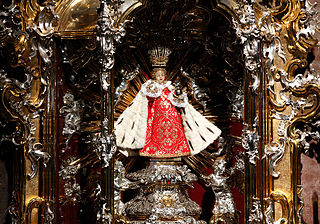
The Most Sacred Heart of Jesus is one of the most widely practised and well-known Catholic devotions, wherein the heart of Jesus Christ is viewed as a symbol of "God's boundless and passionate love for mankind". This devotion to Christ is predominantly used in the Catholic Church, followed by high church Anglicans, and some Western Rite Orthodox. In the Latin Church, the liturgical Solemnity of the Most Sacred Heart of Jesus is celebrated the third Friday after Pentecost. The 12 promises of the Most Sacred Heart of Jesus are also popular.

Our Lady of Fátima is a Catholic title of Mary, mother of Jesus, based on the Marian apparitions reported in 1917 by three shepherd children at the Cova da Iria in Fátima, Portugal. The three children were Lúcia dos Santos and her cousins Francisco and Jacinta Marto. José Alves Correia da Silva, Bishop of Leiria, declared the events worthy of belief on 13 October 1930.

Fresnillo is a city in north central Mexico, founded in 1554 by Francisco de Ibarra. It is the second largest city in Zacatecas state and the seat of Fresnillo municipality. As a rail and highway junction, Fresnillo is the center of a rich mining area known especially for silver, and the location of one of the world's richest silver mines, the Mina Proaño or Fresnillo Mine, which belongs to the Peñoles mining company. Other important economic activities include agriculture, cattle raising, and a mining school. Fresnillo is also the municipal seat of the municipality of the same name which surrounds it. The municipality had a population of 196,538 and an areal extent of 4,947 square kilometres (1,910 sq mi).

The Christ Child, also known as Divine Infant, Baby Jesus, Infant Jesus, the Divine Child, Child Jesus, the Holy Child, Divino Niño, and Santo Niño in Hispanic nations, refers to Jesus Christ from his nativity until age 12.
Santo Niño, which means "holy child", is a Spanish title for the Christ Child and may also refer to:

Mother Mary Angelica of the Annunciation, commonly known as Mother Angelica, was an American Roman Catholic nun of the Poor Clares of Perpetual Adoration. She was best known for the television show Mother Angelica Live. She was the founder of the international broadcast cable television network Eternal Word Television Network (EWTN) and the radio network WEWN. EWTN became a voice for Catholics worldwide.

The Infant Jesus of Prague is a 16th-century wax-coated wooden statue of the Child Jesus holding a globus cruciger of Spanish origin, now located in the Discalced Carmelite Church of Our Lady of Victories in Malá Strana, Prague, Czech Republic. First appearing in 1556, pious legends claim that the statue once belonged to Teresa of Ávila and was consequently donated to the Carmelite friars by Princess Polyxena of Lobkowicz in 1628.

The Señor Santo Niño de Cebú is a Catholic title of the Child Jesus associated with a religious image of the Christ Child widely venerated as miraculous by Filipino Catholics. It is the oldest Christian artifact in the Philippines, originally a gift from the Conquistador Ferdinand Magellan to Rajah Humabon and his wife and chief consort, Hara Humamay on account of their Christian baptism in 1521. The image is the only canonically crowned image of Jesus Christ in the Philippines.

Holy Infant of Atocha, Santo Niño de Atocha, Holy Child of Atocha, Saint Child of Atocha, or Wise Child of Atocha is a Roman Catholic image of the Christ Child popular among the Hispanic cultures of Spain, Latin America and the southwestern United States. It is distinctly characterized by a basket he carries, along with a staff, drinking gourd and a cape to which is affixed a scallop shell, symbol of a pilgrimage to Saint James.

The Holy Infant of Good Health is a statue of the Christ Child regarded by many to be miraculous, which was found in 1939, in Morelia, Michoacán State, Mexico. The statue is eleven inches tall. A number of healings have been attributed to the Child Jesus through veneration of this image.

Our Lady of Peñafrancia is an image of the Blessed Virgin Mary. A Marian image is permanently enshrined in the Minor Basilica of Our Lady of Peñafrancia in Naga, Camarines Sur.

Santuario della Madonna del Divino Amore, or the Shrine of Our Lady of Divine Love, is a Roman Catholic shrine in the southern outskirts of Rome dedicated to the Blessed Virgin Mary that consists of two churches: an old church built in 1745 and a new church added to the sanctuary in 1999. The church was included by Pope John Paul II in the pilgrimage of Seven Pilgrim Churches of Rome during the Holy Year 2000.

The Basílica Minore del Santo Niño de Cebú, alternatively known as the Minor Basilica of the Holy Child or simply Santo Niño Basilica, is a minor basilica in Cebu City in the Philippines that was founded in 1565 by Fray Andrés de Urdaneta and Fray Diego de Herrera. It is the oldest Roman Catholic church in the country, allegedly built on the spot where the image of the Santo Niño de Cebú was found during the expedition of Miguel López de Legazpi.

St.Theresa Church is a Catholic church under the jurisdiction of the Archdiocese of Madras-Mylapore (Chennai-Mylai) in Tamil Nadu, India, in Sembiam division of Perambur, Chennai. Approximately 900 families have the membership in this Catholic parish. Many people from various parts of Chennai make pilgrimage to this church for the devotion of Infant Jesus.

Our Lady of the Most Holy Rosary – La Naval de Manila is a venerated title of the Blessed Virgin Mary associated with the same image in the Philippines. Pious believers believe that the Virgin's intercession under this title helped to defeat the invading forces of the Protestant Dutch Republic during the Battles of La Naval de Manila in 1646.

The Shrine of the Most Blessed Sacrament of Our Lady of the Angels Monastery, informally known as OLAM Shrine, is a prominent Catholic shrine located in Hanceville, Alabama, United States within the Diocese of Birmingham. Adjacent is the cloistered Monastery of the Poor Clare Nuns of Perpetual Adoration, situated on a 400-acre (160 ha) site and a religious center affiliated with the Eternal Word Television Network.

The Bambino Gesu of Arenzano locally known as Il Grande Piccinino is a Roman Catholic image of the Child Jesus venerated by the Genoese faithful.

Our Lady of the Rosary of San Nicolás is, in Catholicism, a title of veneration of the Blessed Virgin Mary associated with a reported private revelation to Gladys Quiroga de Motta, a middle-aged housewife, beginning in the 1980s in the city of San Nicolás de los Arroyos, Argentina. Quiroga said that she was tasked with promoting devotion to the Mother of God under this title, with an emphasis on key passages in the Bible and a particular mystical stellar symbolism.

The Santo Niño de Tondo is a Catholic title of the Child Jesus associated with a religious image of the Christ Child. The image was brought to the Philippines during the expedition of Miguel López de Legazpi in 1572 and is the 2nd oldest image of the Child Jesus in the Philippines, after the Santo Niño de Cebú. The image is enshrined in the Archdiocesan Shrine of Santo Niño de Tondo.




















